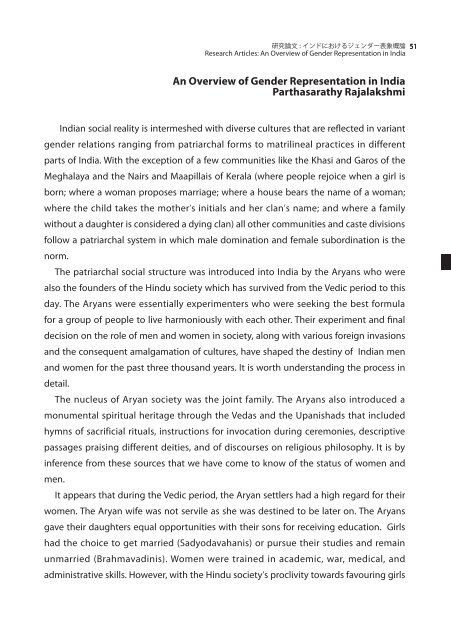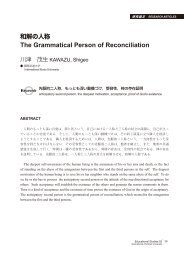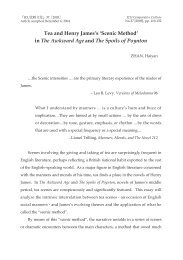Untitled - subsite - å½éåºç£æ大å¦
Untitled - subsite - å½éåºç£æ大å¦
Untitled - subsite - å½éåºç£æ大å¦
You also want an ePaper? Increase the reach of your titles
YUMPU automatically turns print PDFs into web optimized ePapers that Google loves.
: <br />
Research Articles: An Overview of Gender Representation in India 51<br />
An Overview of Gender Representation in India<br />
Parthasarathy Rajalakshmi<br />
Indian social reality is intermeshed with diverse cultures that are reflected in variant<br />
gender relations ranging from patriarchal forms to matrilineal practices in different<br />
parts of India. With the exception of a few communities like the Khasi and Garos of the<br />
Meghalaya and the Nairs and Maapillais of Kerala (where people rejoice when a girl is<br />
born; where a woman proposes marriage; where a house bears the name of a woman;<br />
where the child takes the mothers initials and her clans name; and where a family<br />
without a daughter is considered a dying clan) all other communities and caste divisions<br />
follow a patriarchal system in which male domination and female subordination is the<br />
norm.<br />
The patriarchal social structure was introduced into India by the Aryans who were<br />
also the founders of the Hindu society which has survived from the Vedic period to this<br />
day. The Aryans were essentially experimenters who were seeking the best formula<br />
for a group of people to live harmoniously with each other. Their experiment and final<br />
decision on the role of men and women in society, along with various foreign invasions<br />
and the consequent amalgamation of cultures, have shaped the destiny of Indian men<br />
and women for the past three thousand years. It is worth understanding the process in<br />
detail.<br />
The nucleus of Aryan society was the joint family. The Aryans also introduced a<br />
monumental spiritual heritage through the Vedas and the Upanishads that included<br />
hymns of sacrificial rituals, instructions for invocation during ceremonies, descriptive<br />
passages praising different deities, and of discourses on religious philosophy. It is by<br />
inference from these sources that we have come to know of the status of women and<br />
men.<br />
It appears that during the Vedic period, the Aryan settlers had a high regard for their<br />
women. The Aryan wife was not servile as she was destined to be later on. The Aryans<br />
gave their daughters equal opportunities with their sons for receiving education. Girls<br />
had the choice to get married (Sadyodavahanis) or pursue their studies and remain<br />
unmarried (Brahmavadinis). Women were trained in academic, war, medical, and<br />
administrative skills. However, with the Hindu societys proclivity towards favouring girls













